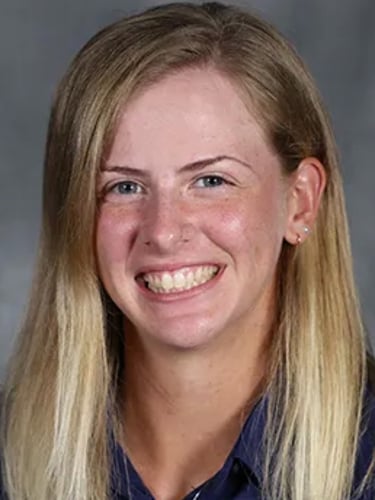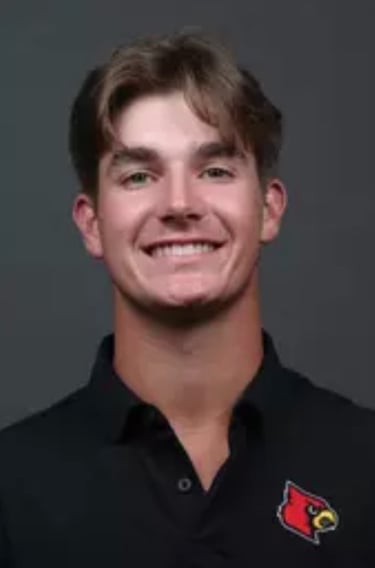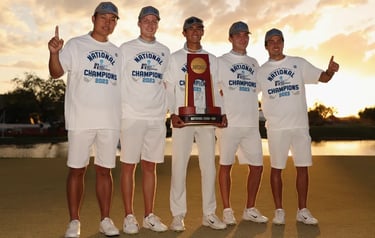

The Ins & Outs of Freshman Year of College: Class of 2023 Perspectives
3/30: CGC Staff


An incoming freshman college golfer has gone through the highs of both commitment and signing days, and the excitement of being a future member of their team. As move-in day nears, what was once a dream in the making soon becomes a reality. It’s time to move away from home, plant the seeds of independence, and learn how to balance the academics of college with the responsibility of being an athlete on part of a team. Move-in day, settling into dorm life, the first day of classes, and initial tournament qualifying all occur in a short time period, and while some may settle into the routine, others may find it stressful. We discussed the transition into freshman year with several top-50 ranked members of the high school graduating class of 2023, and they give future collegiate golfers some valuable insight into the process of settling into the life of a college golfer.
Returning players have the luxury of having played their team’s home courses many times over, but an incoming freshman may have played the courses only a few times on visits. Some freshmen may have the luxury of starting early for summer classes, but those players are in the minority. Qualifying for the first tournament typically begins within the first week while a freshman is dealing with the hectic pace of moving in and starting classes. We asked several cur freshmen to give us some insight into their first qualifying experience. Rocco Salvitti, a first-year student athlete at the University of Notre Dame, moved into his dorm ten days before his first team qualifier. He shares, “This gave me a few days to get used to campus before our first day of classes and allowed me to practice at the facility, play our home course, and scout out our qualifying courses. Everyone had to earn their spot in the lineup, as no exemptions were given for the first event. This meant it was a very competitive five round qualifier. I was able to qualify for the first event and transition into a travel spot.” Kiera Bartholomew, a freshman at the University of Virginia, felt she had ample time to prepare to earn an initial lineup spot, adding “I was excited to officially be part of the University of Virginia women's golf team and to meet and practice with my teammates. Within my first week and a half since arriving on campus, I was able to use our practice facility and play our home course, Birdwood Golf Course, a few times before having to qualify for tournaments.”




Rocco Salvitti, University of Notre Dame
Kiera Bartholomew, University of Virginia
Fifa Laopakdee, a freshman playing for Arizona State University, describes his first qualifying experience as a blast, although he felt his lack of experience with the courses was a disadvantage. “Last fall, the season started pretty early, so we kind of jumped straight into the six-round qualifier called the ‘Scorcher.’ As a freshman, I didn't have much time to prepare for the qualifier courses, probably played some of the courses once or twice, and that's it. Therefore, I had a slight disadvantage among other teammates. However, it didn't interfere with my mindset of playing my best golf and making the lineup,” he states. For University of Louisville first-year Cooper Claycomb, qualifying was definitely an adjustment, as he says “For me qualifying was rough, I felt super rushed and was losing control with my time management. I missed qualifying for the first tournament of the season and I realized I had to make a change, collected myself, and really worked hard while the team was away.”


Fifa Laopakdee, Arizona State University


Cooper Claycomb, University of Louisville
Entering the spring season, both Salvitti and Claycomb have transitioned easily into their team’s lineup, and both play on teams with formidable players. Both shared what their mindset was going in as freshmen trying to crack a tough lineup. “My mindset going into the first qualifier was simple, compete as hard as I possibly can. I took most of August off from tournaments so that I could get my game in shape for a long fall season. This allowed me to be at my best and be fresh when I showed up to campus. I felt ready and hungry to compete. Qualifying is a long process and I felt mentally prepared going in with this understanding,” says Salvitti. Claycomb has a positive outlook into his position on the team, sharing “For me I want to be a team player, I want my scores to count every round I can play. I think as a freshman, I’m kind of a role player, not really in the spotlight, but being there for my teammates and allowing them to count on me to put up a good score is my number one goal. Golf is such an individual sport but in college that changes. I think it’s important to think of the team while you’re out there, as you get three rounds every tournament and it’s a restart every round. I could shoot 80-68-66 and those 68 and 66’s will allow the team to succeed.” The Cavaliers’ Batholomew is a member of a top-25 ranked team and knew that cracking the lineup would be competitive. She states “Our team consists of very talented players who are highly competitive. I maintained a strong mindset, knowing that I had the skills and ability to compete for a tournament lineup position. I made sure to keep everything simple and to trust my ability to play high-level golf because it has already gotten me this far. At the end of the day, I knew I needed to focus on myself and just play against each hole of the golf course.” Sundevil Laopakdee is a member of an elite, experienced team of golfers, with intense competition for lineup spots in every qualifier. At Arizona State, any player could make the lineup on any given week. One of the reasons he came to Arizona State was that he wanted to challenge himself and be with players who were better than him. “For me, the only way to make me a better golfer and a better person is to be around the guys who have more experience than me. Since the start, I know we have some of the best college golfers in the world, and making the lineup as a freshman will be extremely tough. However, I took this challenge as a motivation to grind harder than ever. Fortunately, I was able to make the lineup for some of the events in my first semester.”
"Notre Dame has so many resources for student athletes that allow me to stay ahead and get help when I need it. We have mandatory study hall two days per week for two hours each day. This time allowed me to get all the work done I needed to and stay ahead when I knew we would be gone for multiple days at a time. Many people told me that there were plenty of academic resources, but I was caught off guard by how many resources there truly are and how if you create a relationship with your professors, they will help you in any way possible.” -Rocco Salvitti


In addition to adapting to the rigors of college golf, an athlete needs to make the adjustment from high school to the demands of college academics. Freshmen likely have certain expectations going into their first semester. We asked the athletes if there was anything about school that surprised them or caught them off guard. Laopakdee was surprised at how kind and friendly his professors and classmates were, saying “In my first semester, I was obviously excited and nervous about entering the new life chapter in college. I have made some great relationships with my classmates and professors, dramatically improving my school life, including academics.” Claycomb had a relatively easy transition to his core classes. “The first semester was pretty easy as it was normal Gen Ed classes, but the amount of work in my spring semester has been a decent amount, not impossible but definitely a task when dealing with practices and games.”
Being at a rigorous academic school at Notre Dame, Salvitti credits the school’s resources for helping ease his transition to college academics, stating “Going into Notre Dame, I was a little bit worried about the academic rigor. I knew my high school prepared me, but now I would be traveling often and missing many school days. Notre Dame has so many resources for student athletes that allow me to stay ahead and get help when I need it. We have mandatory study hall two days per week for two hours each day. This time allowed me to get all the work done I needed to and stay ahead when I knew we would be gone for multiple days at a time. Many people told me that there were plenty of academic resources, but I was caught off guard by how many resources there truly are and how if you create a relationship with your professors, they will help you in any way possible.” Bartolomew also expected the academic curriculum at Virginia to be challenging and tried to take the steps in high school to prepare her for her freshman year of college, saying “I took a rigorous course load in high school, so I learned how to manage my time efficiently, which helped me a lot as I entered my first semester. I also decided to take a lighter course schedule, keeping it at twelve credits, for my first semester to have a smoother transition from high school to college.”
Salvitti further elaborates of his experience with academic support, “You may think you’ll be able to do everything on your own, which you very well could, but academic support will always keep you pointed in the right direction. We have an athletic academic advisor that monitors our grades and reports to coaches, but also knows which professors are helpful with all of the classes we miss. Golf misses the most class time of any athletic team on campus, so it is important to keep close with the advisor. My process for keeping up with academics includes emailing my professor a week prior to tell them when I will be missing class. This allows me to have a good relationship with my professors. They appreciate when you reach out to them and know you care about the class. School work is very manageable, as long as you do your best to stay ahead. The season is extremely busy and there are times when you aren’t in class for an entire week.” Batholomew appreciates the great academic support she receives at Virginia, adding “I have an academic coordinator who helps me with academic questions regarding tutoring or scheduling. My academic coordinator also provides travel notification letters at the beginning of each semester to give to our professors. This lets the professors know that I may be absent from classes due to competitive golf tournaments. Along with the academic coordinator, each student gets an advisor for their chosen field of study. Your assigned advisor helps student-athletes pick out courses and provides helpful curriculum advice. The balance between the two can be hard at times because you may not have time to meet with professors or to pick certain classes due to scheduling conflicts. Athletes can still find a way to make it manageable because of the support given to them. The best way to balance it all is proper time management and communication. My professors have been accommodating because I frequently communicate with them about the course material and if I will be missing any classes because of tournaments. When professors see you are putting in an effort inside the classroom and communicating about your athletic schedule, they are more willing to help you succeed. Time management is key. You have to maximize your time by completing class assignments and studying in between practice and while traveling for tournaments.” Claycomb also appreciates his academic team at Louisville, adding “Our academic help is awesome, as we have countless tutors and our own personal spaces. This was a main draw for me at Louisville because I’m surrounded by people that care for me and want to help me succeed, not only in golf but in the classroom.” Laopakdee also credits his academic advisor, saying “At ASU, we have an academic advisor who helps us with almost anything academically, such as assigning a tutor, class registration, homework, etc. As a student-athlete, balancing my school and golf life can be hard sometimes, so we have to find what timetable fits us the best. For me, it's school in the morning, practice in the afternoon, and finishing assignments before bed. I like to finish as many assignments as possible at the start of the week because I will have more free time at the end of the week. I never do the assignment at the last minute. Fortunately, I was able to finish my first semester with a 4.2 GPA.” Way to go, Fifa!


Sun Devil practice facility
Balancing schoolwork and practice can be manageable, but what does college golf practice look like? All of the athletes note that practice can look different on each day, as athletes can have varied practice habits. “A team practice is very different every day. We have days when we work on what we want to work on, but the majority of practices are drills and challenges against each other. This helps mimic those stressful situations that occur in tournament play. Coaches Blagg and Hand do a great job creating new practices every week,” notes Claycomb. At Arizona State, the practices seem regimented, challenging, and fun. Laopakdee notes, “We do various fun drills in each team practice, depending on what the coaches want us to work on. Whether it's ‘Stiffy,’ where you have to hit the ball inside the circle from various distances, or ‘Wedgeman,’ where we have to make as many up-and-downs as possible within 54 holes around the green, and many more. The coaches always keep track of our score in every team practice, and we must score higher the next time to sharpen our game.”
Salvitti adds, “Team practices vary. At Notre Dame, we keep practices very competitive. Typically, practice is 2 hours. For the first 30 minutes - 1 hour we work on our own process and warm up. The second hour is competition, whether that be wedge combines, putting drills, or on course work, you are competing in some way. During this time, you can also work with coaches on your swing or talk through certain shots with them. Having a great facility and course on the corner of campus makes it very accessible whenever you want to use it.” Bartholomew says practices are both hard and fun, “Several days a week we do a mix of both team drills and individual drills, as well as physical training. During the team practice, we do a lot of target practice, wedge shots, and putting drills. We will also compete in teams against each other based on specific drills given by our coach. The drills for each week vary and are mainly based on statistics from each previous round of golf played. During the individual drills, we work separately on specific individual skills that assist in improving each player's game. We also have on-course practice with a variety of challenges provided by our coaches that hone our skills for competition.”
Practice involves a mix of experienced college players and new freshman, and at the beginning of freshman year, the ‘newbies’ can learn a lot from the upperclassmen. We asked each athlete what three things they’ve learned from the upperclassmen on their team. Salvitti has found the older players to be valuable assets as he navigates his first year, saying “They are always there to help and show me the ropes of college golf. The three most important things they have taught me are: 1. Have a good balance between life and golf. The golf season is very long, it is important to have friends outside of the team and enjoy life outside of golf. 2. Be ready for adversity. Everyone will face adversity at some point in their freshman year. Be ready for it and know that your teammates, coaches, and advisors are there to help you. 3. Represent Notre Dame and yourself with pride. The networking opportunities that come with playing a sport for Notre Dame are simply incredible. Treat everyone with respect and they will be willing to help you with any advice that you need down the road.” Laopaksee simply states, “1: Always be humble and willing to learn something new every day. 2: This path is not easy at all; the only way to be on top is with consistent self-discipline. 3: Always be hungry for more wins.” Bartholomew sees a strong work ethic in those around her, saying “Three important things that I have learned so far from the upperclassmen on my team are to maintain a strong work ethic, remember to have fun and think of the positives, and to always lift those around you up.” Claycomb likes the accountability that his teammates hold for each other, adding “Three main things I’ve learned from the upperclassmen are the importance of being on time, being committed to my game, and learning how to lead others by example. The guys here are all about hard work; no slack is given. They hold everyone accountable and just love the grind.”
“Three main things I’ve learned from the upperclassmen are the importance of being on time, being committed to my game, and learning how to lead others by example. The guys here are all about hard work; no slack is given. They hold everyone accountable and just love the grind.”- Cooper Claycomb, University of Louisville


2023 Division I champion, University of Florida
Photo: Golfweek
That grind can be rewarding. When asked what the best part about being a division I athlete is, Salvitti responded with “Traveling with your teammates and competing. Nothing beats competition and playing sweet courses.” Claycomb concurs and agrees that the travel and food are rewarding, saying that they ‘get treated like royalty’ everywhere they go. Both he and Laopaksee agree that the downside of being a Division I athlete is the time commitment. Claycomb says “The one negative thing about being an athlete is the lack of free time and scheduling, you’re not on your schedule anymore. You have to build it around school, practice, games and more. It gets crammed and causes a lot of tension, so staying alert and making sure you don’t forget things gets brutal.” Even though the time commitment is hard, Laopaksee takes positives from competing at the highest level, “The best part of being a Division I athlete and on an elite golf team is that I get to play against the top college golfers in every event, which teaches me some vital lessons every time. Therefore, it always pushes me to be a better player every day.”
Bartholomew values the community Division I athletics creates, noting “As a Division I athlete you are playing at the highest level of amateur sports, and I think the best part is definitely the community. You are able to go into college and connect with a group of people who have similar experiences to your own. As an athlete, being a part of a team is great because you have a built-in support group to help you when you have tough situations thrown at you. It is also exciting to be a representative of the University. Younger athletes look up to you and aspire to be in the same position as a member of a collegiate golf team after high school. The hardest part about being a student-athlete is balancing academics and athletics. For example, picking classes and times that will work with your athletic schedules. It can be tough, but you learn to adapt and can make it work. It is also helpful to communicate with the coach and professors as much as possible and to take advantage of available student resources to be successful.”
Incoming and future college freshman can learn some valuable lessons and gain important knowledge from the current freshman class. Each of our participants offers some final words of wisdom to the freshmen of the future:
Rocco Salvitti: In preparation for your first year, I would do two things. Create structure in your day-to-day life. Days of a D1 athlete are very long. Oftentimes you are up very early for workouts and up late doing schoolwork after practice. If you are used to having structure, it will be easier for you to adapt to college life. Secondly, reach out to your future teammates and other incoming freshmen. You are all about to start a new journey, and it makes it much easier if you do it together. At Notre Dame we have a great freshman class. We have many classes together and spend a lot of time together. The transition into Notre Dame would not have been as easy for me if it wasn’t for my teammates and especially my class. Create structure and reach out to your teammates, and this will help you to be prepared for your freshman year.
Cooper Claycomb: The best piece of advice I could give is get ready for college before college. Go do early workouts, go grind all types of drills and be ready to learn. If you do not act like a sponge and soak up all the information that is given, it will be hard to be better. Allow your coaches and teammates to critique you and don’t be ashamed to admit the weak parts of your game.
Kiera Bartholomew: Stay patient and trust the process. College is a new stage of life with a lot of changes, so embrace the changes. There will be a lot thrown at you very quickly during your first semester, but just remember how you got here, and that you are where you are meant to be. Take advantage of all the university resources available to you and don't be afraid to ask other students and your teammates for support as you adjust to college life.
Fifa Laopakdee: Remember these three H's: Humble, Hungry, and Happy. College golf is a challenging path, so you must always grind and practice. Consistency is the key. Furthermore, learn how to be a great teammate and leader; the coaches dislike when you act arrogant with your teammates. Learn how to behave on and off the course and always bring positive energy into the team's environment. Finally, be a good student academically. You have to find a way to make your golf game better and keep good grades in school at the same time.

